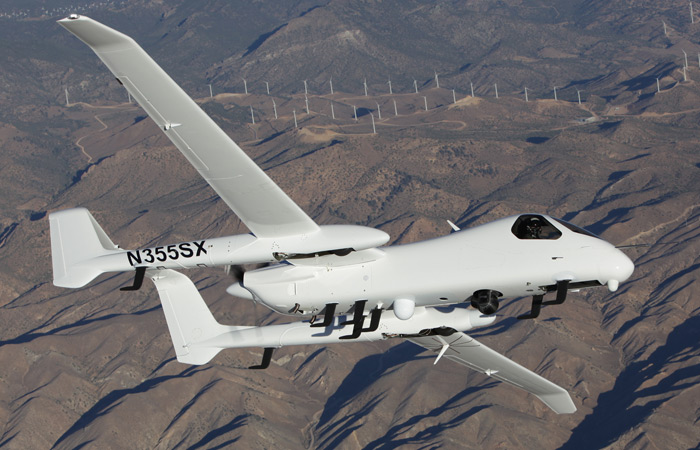
This is the first official photo of the new Optionally Pilot Vehicle (OPV) from Northrop Grumman. It was developed in 12 months from Scaled Composites and it aspires to break the monopoly of General Atomics monopoly that dominates the market (especially in the USA) with Predator A and B variants. The aircraft has the quite unimaginative name Firebird and it has made already a few test flights with various payloads.---

(Photo by Jon Wright used under permission, original photo )
The main key feature is the ability to fly optionally manned. In practice that means that the Firebird can transit manned to the area of interest through civil airspace without the overcomplicated procedures that regular UAVs have to follow. At its mission site it can operate unmanned and take full advantage of its endurance capabilities. Optionally manned aircraft have more trouble free development because the pilot is a crucial safety net. This concept is exploited in other concepts like the unmanned K-Max from Kaman/Lockheed or the unmanned Boeing AH-6. However while those systems where derivatives of manned civil models; the Firebird is designed from scratched.
The other core capability is its versatile architecture; payloads and sensors can be quickly integrated on the spot for various missions. It can also provide services to different ground teams simultaneously. During the official unveil at the end of May at the Empire Challenge event it will demonstrate its ability to carry four separate payloads, sensors and communications modules. The payload sets have HD video, optical/IR sensors, data relay and electronic support. The demo will also include a quick payload reconfiguration between flights. Although not tested yet for weapons delivery it has one hard point on each wing for carrying missiles (ex AGM-114s).
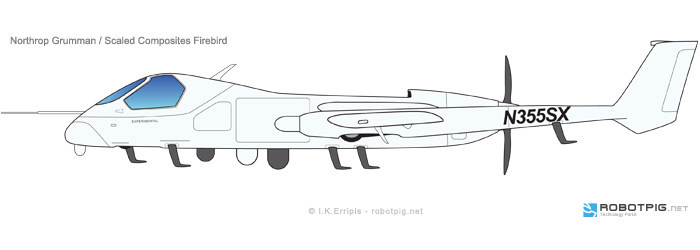
The Firebird is slightly larger than a Predator A but it has significantly improved performance. It has more than double MTOW, 200kt cruise speed (Predator A ~90-100kt), max altitude 30.000ft (Predator A ~25.000) and most importantly it is capable of staying up to 40hr on air (Predator A: 24h). Like the Predator A and other UAVs of this size it has a 4-stroke reciprocating engine, provided by Lycoming
The twin-boom arrangement is very close to other UAVs and also to Scaled Model 309 (that later became Adam M-500) albeit with only one engine. It has a slightly forward swept outer wing and with its high aspect ratio and very streamlined fuselage it is optimized for loiter and long endurance flights.
Northrop aspires to catch a small but not negligible part of the market now dominated by General Atomics. The optionally piloted feature can be very crucial at condensed airspace in places like Europe. Many European countries operate and train their military UAV fleet abroad because of airspace restrictions. A manned aircraft can operate freely even if the pilot is used only for supervising or even just as a safety measure.
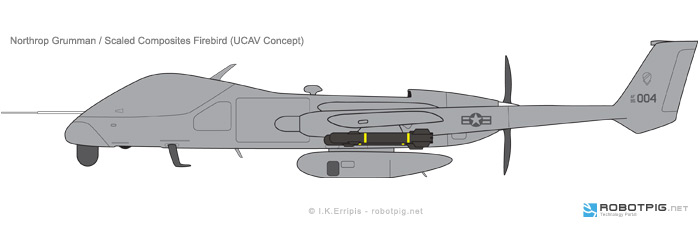
The US are not particularly interested in the manned option although it can replace several manned aircraft converted from commercial models like the MC-12W. However we can speculate that if needed the Firebird could easily become a family of both OPV and strictly UAV aircraft. It may even become a re-configurable aircraft where the pilot area can be replaced by a satcom dish, a capability currently absent on the OPV Firebird. Of course this is pure speculation but considering the structure of the aircraft, its very flexible architecture and also the extremely compact avionics interface that Scaled is renowned for (like the SpaceShipOne cockpit in the photo below), that is a quite plausible scenario.
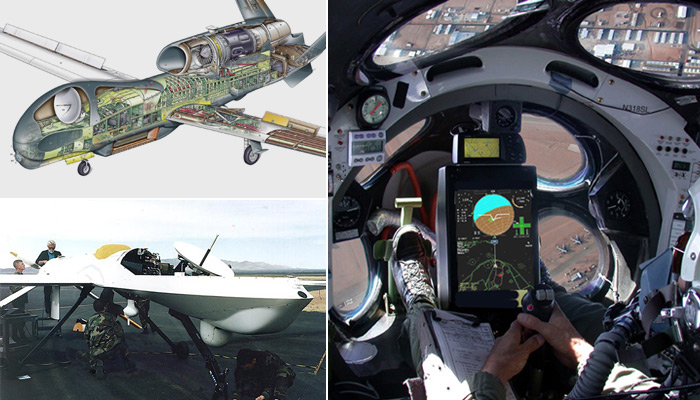
(photos: Northrop Grumman top left, General Atomics down left, Scaled Composites right)
The cockpit could possibly be bolt on and with versatile plug and play avionics it can be replaced with a satellite dish (similar to a RQ-4, MQ-1, photos above) and remote communications module relatively fast. In this case the aircraft could fly manned to the place of interest, it can be converted on-site and after it can be operated via satellite from a central headquarters like today’s large UAVs like the MQ-9 and RQ-4.
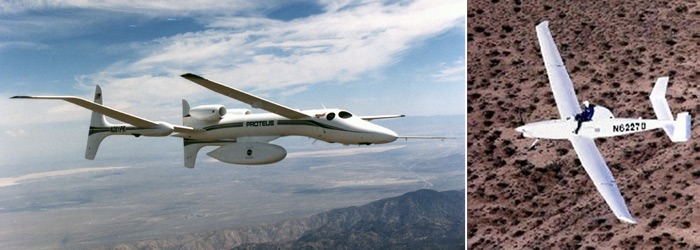
(Photos NASA left, Scaled Composites right)
Scaled Composites has a huge experience in unmanned systems, they have developed some of the first aerial target drones and UAVs of Teledyne Ryan, the X-47A and X-47B for Northrop Grumman, the also optionally manned Proteus research aircraft (photo above left) and others. However the most impressive ‘optionally manned’ ride must be credited to test pilot Douglas Shane that flew over the Model 226/Quiver during its development phase. The same model later evolved to an optionally manned droned with a semi-open cockpit.
[ytx="hFsFMYoUju8"]hFsFMYoUju8[/ytx]
More info:
http://www.aviationweek.com
http://www.flightglobal.com
http://www.militaryphotos.net/forums
Graphics: I.K.Erripis - VelocityFarm